| Cherokee Nation
ᏣᎳᎩᎯ ᎠᏰᎵ | |||||
| Autonomous region of the United States. | |||||
| |||||
Southeastern U.S. and Indian territories, including Cherokee, Creek, and Chickasaw; 1806
| |||||
| Capital |
| ||||
| Languages | Cherokee | ||||
| Government | Autonomous tribal government | ||||
| Principal Chief | |||||
| - | 1794-1907 | Principal Chief | |||
| - | 1794-1905 | Tribal Council | |||
| Historical era | Post-colonial to early 20th century | ||||
| - | Created with the Treaty of Tellico Blockhouse | November 07, 1794 1794 | |||
| - | New Echota officially designated capital city | 12 November 1825 | |||
| - | Treaty of New Echota | 29 December 1835 | |||
| - | Cherokee Trail of Tears | 1838-1839 | |||
| - | Tahlequah becomes new official capital | 6 September 1839 | |||
| - | Officially disbanded by US Federal Government | November 16, 1907 1907 | |||
| Currency | US dollar | ||||
| Today part of | - | ||||
Template:Contains Cherokee text The Cherokee Nation (ᏣᎳᎩᎯ ᎠᏰᎵ, pronounced Tsalagihi Ayeli[1]) from 1794–1907 was a legal, autonomous, tribal government in North America recognized from 1794 to 1907. Often referred to simply as "The Nation" by its inhabitants, it should not be confused with what is known in the 21st century also as the Cherokee Nation.
It consisted of the Cherokee (ᏣᎳᎩ —pronounced Tsalagi or Cha-la-gee) people of the Qualla Boundary and the southeastern United States;[2] those who relocated voluntarily from the southeastern United States to the Indian Territory (circa 1820 —known as the "Old Settlers"); those who were forced by the Federal government of the United States to relocate (through the Indian Removal Act) by way of the Trail of Tears (1830s); Cherokee Freedmen (freed slaves); as well as many descendants of the Natchez, the Delaware and the Shawnee peoples.
History[]
The Cherokee called themselves the Ani-Yun' wiya. In their language this meant "leading" or "principal" people. Before 1794, the Cherokee had no standing national government. The people dwelt in "towns" located in scattered autonomous tribal areas related by kinship throughout the southern Appalachia region. Various leaders were periodically appointed (by mutual consent of the towns) to represent the tribes to French, British and, later, American authorities as was needed. The title this leader carried among the Cherokee was "First Beloved Man"[3] —being the true translation of the title Uku, which the English translated as "chief". The chief's function was to serve as focal point for negotiations with the encroaching Europeans, such as the case of Hanging Maw, who was recognized as chief by the United States government, but not by the majority of Cherokee peoples.[4]
At the end of the Cherokee–American wars (1794), Little Turkey was recognized as "Principal Chief of the Cherokee Nation" by all the towns. At that time, Cherokee tribes could be found in lands nominally under the jurisdiction of Georgia, North Carolina, South Carolina, and the Overhill area that was to become part of the state of Tennessee. The break-away Chickamauga band (or Lower Cherokee), under chief Dragging Canoe (Tsiyugunsini, 1738–1792), had retreated to and now inhabited an area that would be the northern area of the future state of Alabama.[5]
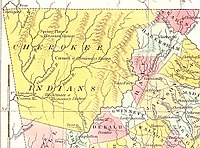
The Cherokee Nation Lands in 1830 Georgia, before the Trail of Tears
U.S. president George Washington sought to "civilize" the southeastern American Indians, through programs overseen by US Indian Agent Benjamin Hawkins. Facilitated by the destruction of many Indian towns during the American Revolutionary War, U.S. land agents convinced many Native Americans to abandon their historic communal-land tenure and settle on isolated farmsteads. Over-harvesting by the deerskin trade had brought white-tailed deer in the region to the brink of extinction; therefore, pig and cattle raising were introduced, becoming the principal sources of meat. The tribes were supplied with spinning wheels and cotton-seed, and men were taught to fence and plow the land (in contrast with their traditional division of labor in which most cultivation for farming was considered woman's work). Women were instructed in weaving. Eventually blacksmiths, gristmills and cotton plantations (along with slave labor) were established.[6]
Succeeding Little Turkey as Principal Chief were Black Fox (1801–1811) and Pathkiller (1811–1827), both former warriors of Dragging Canoe. "The separation", a phrase which the Cherokee used to describe the period after 1776 when the Chickamauga had removed themselves from the other tribes which were in close proximity to the Anglo-American settlements, officially ended at the reunification council of 1809.
Three important Cherokee–American wars veterans of the time, James Vann (a successful Scots-Cherokee businessman) and his two protégés, Major Ridge (1771-1839) (also called Ganundalegi or "The Ridge") and Charles R. Hicks, made up the 'Cherokee Triumvirate' —advocating acculturation of the people, formal education of the young, and the introduction of modern farming methods. In 1801 they invited Moravian missionaries to their territory from North Carolina to teach Christianity and the 'arts of civilized life.' The Moravian, and later Congregationalist, missionaries ran boarding schools, with a select few students chosen to be educated at the American Board of Commissioners for Foreign Missions school in Connecticut.
These men continued to be leaders in the tribe. Hicks participated in the Red Stick War, which coincided with part of US involvement in the War of 1812. He was the de facto Principal Chief from 1813–1827.
The Removal[]

The Arkansaw Territory division: showing the progression of Indian Territory separation from Arkansas Territory, 1819–1836
In 1802, the U.S. federal government promised to extinguish Native American titles to internal Georgia lands in return for the state's formal cession of its unincorporated western claim (which was made part of the Mississippi Territory). In 1815, the US government established a Cherokee Reservation in the Arkansaw district of the Missouri Territory and tried to convince the Cherokee to move there voluntarily. The reservation boundaries extended from north of the Arkansas River to the southern bank of the White River. The Cherokee who moved to this reservation became known as the "Old Settlers".[7]

Map of Southern United States during the time of the Indian Removals (Trail of Tears), 1830–1838, showing the historic lands of the Five Civilized Tribes. The destination Indian Territory is depicted in light yellow-green.
Additional treaties signed with the U.S., in 1817 and 1819, exchanged remaining Cherokee lands in Georgia (north of the Hiwassee River) for lands in the Arkansaw Territory west of the Mississippi River. A majority of the remaining Cherokee resisted these treaties and refused to leave their lands east of the Mississippi. Finally, in 1830, the United States Congress enacted the Indian Removal Act to bolster the treaties and forcibly free up title to the sought over state lands. At this time, one-third of the remaining Native Americans left voluntarily, especially because now the act was being enforced by government troops and the Georgia militia.
Most of the settlements were established in the area around the western capital of Tahlontiskee (near present-day Gore, Oklahoma).
Constitutional governments[]
The Cherokee Nation—East had first created electoral districts in 1817. By 1822, the Cherokee Supreme Court was founded. Lastly, the Cherokee Nation adopted a written constitution in 1827 creating a government with three branches: legislative, executive, and judicial. The Principal Chief was elected by the National Council, which was the legislature of the Nation. A similar constitution was adopted by the Cherokee Nation—West in 1833.
The Constitution of the reunited Cherokee Nation was ratified at Tahlequah, Oklahoma on September 6, 1839, at the conclusion of "The Removal". The signing is commemorated every Labor Day weekend with the celebration of the Cherokee National Holiday.
Removal[]
Founded in 1838, Tahlequah was developed as the new capital of a united Cherokee Nation. (It was named after the historic Great Tellico —an important Cherokee town and cultural center in present-day Tennessee that was one of the largest Cherokee towns ever established. The mostly European-American settlement of Tellico Plains developed later at that site.
Cherokee Nation districts in Indian Territory[]
After moving to Indian Territory, the Cherokee Nation was divided into nine districts for administrative purposes. Those were named:[1]
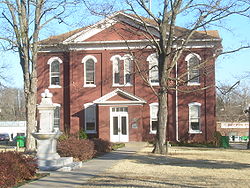
The Cherokee Nation Capitol Building and Courthouse, Tahlequah, Oklahoma. Built in 1869, it functioned as the political center of "The Nation" until 1907, and is the oldest public building standing in Oklahoma.[8]
- Canadian
- Cooweescoowee
- Delaware
- Flint
- Goingsnake
- Illinois
- Saline
- Sequoyah
- Tahlequah
Cherokee Capital[]
The Cherokee National Capitol Building was constructed from 1867-1869.[9] The brick building was designed by architect C. W. Goodlander in the 'late Italianate' style, which was unusual for Oklahoma. Originally it housed the nation's court as well as other offices. It was declared a National Historic Landmark in 1961.[9][10][11]
Indications of Cherokee and Native American influence are easily found in and about Tahlequah. For instance, street signs appear in the Cherokee language—in the syllabary alphabet created by Sequoyah (ca. 1767–1843)[12]—as well as in English.
Civil War and Reconstruction[]
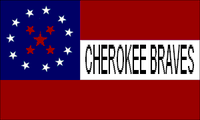
The Cherokee Braves Flag, as flown by Stand Watie's troop.
The Trans-Mississippi area, which included the Cherokee Nation–West, hosted numerous skirmishes and seven officially recognized battles involving Native American units either allied with the Confederate States of America or loyal to the United States government.
Several prominent members of the Cherokee Nation made contributions during the war: William Penn Adair (1830–1880), a Cherokee senator and diplomat, was a Confederate colonel; Nimrod Jarrett Smith, Tsaladihi (1837–1893), a future Principal Chief of the Eastern Band, also served during the war; and hold-out Confederate Brig. General Stand Watie (also known as Degataga, (1806–1871), a signer of the Treaty of New Echota) raided Union positions in the Indian Territory with his 1st Cherokee Mounted Rifles Regiment of the Army of Trans-Mississippi well after the Confederacy had abandoned the area. He became the last Confederate general to surrender—on June 25, 1865.[13]
The main body of the Cherokee people had sided with the Confederacy during the American Civil War. After the war, the United States negotiated a peace treaty with them, requiring them to emancipate their slaves and to offer them citizenship and territory within the reservation if the freedmen chose to stay with the tribe. The area also became part of the reconstruction of the former Confederate States overseen by military and appointed governors.
Nation's demise[]
President Benjamin Harrison September 19, 1890, stopped the leasing of land in the Cherokee Outlet to cattlemen. The lease income had supported the Cherokee Nation in its efforts to prevent further encroachments on tribal lands.[14]
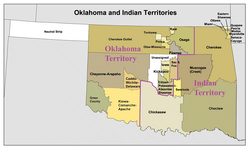
Oklahoma Territory and Indian Territory, along with No Man's Land (also known as the Oklahoma Panhandle). The division of the two territories is shown with a heavy purple line. Together, these three areas would become the State of Oklahoma in 1907
From 1898–1906, beginning with the Curtis Act of 1898, the US federal government set about the dismantling of the Cherokee Nation's governmental and civic institutions, in preparation for the incorporation of the Indian Territory into the new state of Oklahoma. In response, the leaders of the Five Civilized Tribes sought to gain approval for a new State of Sequoyah in 1905 that would have a Native American constitution and government. The proposal received a cool reception in Congress and failed. The tribal government of the Cherokee Nation was dissolved in 1906. After this the structure and function of the tribal government were not formally defined. The federal government occasionally designated chiefs of a provisional "Cherokee Nation", but usually just long enough to sign treaties.[15]
As the shortcomings of the arrangement became increasingly evident to the Cherokee, demand arose for the formation of a more permanent and accountable tribal government. New administrations at the federal level also recognized this issue, and the Franklin D. Roosevelt administration gained passage of the Indian Reorganization Act of 1934, encouraging tribes to re-establish governments and supporting more self-determination. The Cherokee convened a general convention on 8 August 1938 in Fairfield, Oklahoma, to elect a new Chief, and reconstitute a modern, Cherokee Nation, to be a "successor in interest" to the historic Cherokee Nation.[16]
People[]
The Nation was made up of scattered peoples mostly living in the Cherokee Nation–West and the United Keetoowah Band of Cherokee Indians (both residing in the Indian Territory by the 1840s), and the Cherokee Nation–East (Eastern Band of Cherokee Indians); these became the three federally recognized tribes of Cherokee in the 20th century.
Additional peoples[]
The Delaware[]
In 1866, some Delaware (Lenape) were relocated to the Cherokee Nation from Kansas, where they had been sent in the 1830s. Assigned to the northeast area of the Indian Territory, they united with the Cherokee Nation in 1867. The Delaware Tribes operated autonomously within the lands of the Cherokee Nation.[17]
Natchez people[]

Tahlequah, Oklahoma stop sign, written in English and Cherokee
The Natchez are a Native American people who originally lived in the Natchez Bluffs area. The present-day city of Natchez, Mississippi developed in their former territory. By the mid-eighteenth century, the Natchez people were defeated by French colonists and dispersed from there. Many survivors had been sold (by the French) into slavery in the West Indies. Others took refuge with allied tribes, one of which was the Cherokee.
The Shawnee[]
Known as the Loyal Shawnee or Cherokee Shawnee, one band of Shawnee people relocated to Indian Territory with the Seneca people (Iroquois) in July 1831. The term "Loyal" came from their serving in the Union army during the American Civil War. European Americans encroached and settled on their lands after the war.
In 1869, the Cherokee Nation and Loyal Shawnee agreed that 722 of the Shawnee would be granted Cherokee citizenship. They settled in Craig and Rogers counties.[18]
Swan Creek and Black River Chippewa[]
The Anishinaabe-speaking Swan Creek and Black River Chippewa bands were removed from southeast Michigan to Kansas in 1839. After Kansas became a state and the Civil War ended, European-American settlers pushed out the Native Americans. Like the Delaware, the two Chippewa bands were relocated to the Cherokee Nation in 1866. They were so few in number that they eventually merged with the Cherokee.
Cherokee Freedmen[]
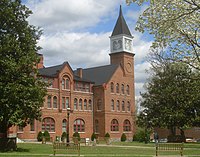
The second Cherokee Female Seminary was opened in 1889 by the original Cherokee Nation.
The Cherokee Freedmen, were former African American slaves who had been owned by citizens of the Cherokee Nation during the Antebellum Period. President Lincoln issued the Emancipation Proclamation in 1863 that granted citizenship to all freedmen in the Confederate States, including those held by the Cherokee. In reaching peace with the Cherokee — who had sided with the Confederacy — the U.S. government required that they free their slaves and offer full Cherokee citizenship to those who wanted to stay with the nation. The freedmen were first guaranteed Cherokee citizenship under a treaty with the United States following the Civil War (1866).[19]
Notable Cherokee Nation citizens[]
This list of historic people includes only documented Cherokee living in, or born into, the original Cherokee Nation who are not mentioned in the main article:
- Elias Boudinot, Galagina (1802–1839), statesman, orator, and editor; founded the first Cherokee newspaper, the Cherokee Phoenix. Assassinated by opponents for signing the New Echota Treaty to cede lands in the East.
- Ned Christie (1852–1892), statesman, Cherokee Nation senator, infamous outlaw[20]
- Rear Admiral Joseph J. Clark (1893–1971), United States Navy, highest-ranking Native American in US military history.
- Doublehead, Taltsuska (d. 1807), a war leader during the Cherokee–American wars, led the Lower Cherokee, and signed land deals with the U.S.
- Junaluska (ca. 1775–1868), veteran of the Creek War, who saved President Andrew Jackson's life.
- Major Ridge (1771-1839) - (aka:Pathkiller II, Nunnehidihi, or Ganundalegi) was a Cherokee warrior/leader, allied to General Andrew Jackson (1767-1845) in the Creek and Seminole Wars. He played a major role in forced removal of the Cherokee nation and the infamous Trail of Tears to Oklahoma in 1837.
- John Ridge, Skatlelohski (1792–1839), son of Major Ridge, statesman and signer of New Echota Treaty signer, assassinated by opponents.
- John Rollin Ridge, Cheesquatalawny, or "Yellow Bird" (1827–1867), grandson of Major Ridge, first Native American novelist.
- Clement V. Rogers (1839–1911), Cherokee senator, judge, cattleman, member of the Oklahoma Constitutional Convention.
- Will Rogers, (November 4, 1879 – August 15, 1935) Cherokee entertainer, roper, journalist, and author.[21]
- John Ross, Guwisguwi (1790–1866), veteran of the Red Stick War, Principal Chief in the east during Removal, and in the west.
- Redbird Smith (1850–1918), traditionalist, political activist, and chief of the Keetoowah Nighthawk Society.
- William Holland Thomas, Wil' Usdi (1805–1893), non-Native who was adopted into tribe, founding Principal Chief of the Eastern Band of Cherokee Indians, commanding officer of the Thomas Legion of Cherokee Indians and Highlanders.
- Nancy Ward, Nanye-hi (ca. 1736–1822/4), Beloved Woman, diplomat.
See also[]
- Cherokee military history
- Cherokee Commission
- Timeline of Cherokee removal
References[]
- ^ a b The James Scrolls
- ^ Indians, Eastern Band of Cherokees of North Carolina; Donaldson, Thomas; 1892; 11th Census of the United States; Robert P. Porter, Superintendent, U.S. Printing Office, Washington, D.C.; published online at Eastern Band of Cherokees of North Carolina; retrieved October 1, 2010.
- ^ Hoig, pp. 36, 37, 80
- ^ A Small Lexicon of Tsalagi words at Web Citations; A Few Words in Cherokee/Tsalagi; Tsalagi resources; accessdate January 18, 2010.
- ^ Evans, E. Raymond. "Notable Persons in Cherokee History: Dragging Canoe"; Journal of Cherokee Studies, Vol. 2, No. 2, pp. 170–190; (Cherokee: Museum of the Cherokee Indian); 1977.
- ^ Perdue, Theda; Cherokee Women: Gender and Culture Change, 1700–1835; Lincoln: University of Nebraska Press; 1999. ISBN 978-0-8032-8760-0.
- ^ Lowery, Charles D. "The Great Migration to the Mississippi Territory, 1798–1819," Journal of Mississippi History, 1968 30(3): 173–192
- ^ Moser, George W. A Brief History of Cherokee Lodge #10., Retrieved 26 June 2009.
- ^ a b Francine Weiss (1980). "[[[:Template:NHLS url]] National Register of Historic Places Inventory-Nomination: Cherokee National Capitol]" (pdf).
- ^ "Cherokee National Capitol". National Historic Landmark summary listing. National Park Service, added = October 15, 1966. http://tps.cr.nps.gov/nhl/detail.cfm?ResourceId=460&ResourceType=Building. Retrieved 2008-01-15.
- ^ "National Register Information System". National Register of Historic Places. National Park Service. 2007-01-23. http://nrhp.focus.nps.gov/natreg/docs/All_Data.html.
- ^ Sequoyah, "New Georgia Encyclopedia"; retrieved 8 Aug 2010.
- ^ Confer, Clarissa; The Cherokee Nation in the Civil War; University of Oklahoma Press; 2007; pg. 4.
- ^ Rennard Strickland, "Cherokee (tribe)," Encyclopedia of Oklahoma History and Culture. Accessed April 18, 2015.
- ^ Cherokee Archived October 8, 2014, at the Wayback Machine; article; Oklahoma Historical Society; "Encyclopedia of Oklahoma History and Culture."
- ^ Indian Country Today article Archived October 7, 2009, at the Wayback Machine
- ^ McCollum, Timothy James. Delaware, Western. Oklahoma Historical Society's Encyclopedia of Oklahoma History & Culture. . Retrieved 5 August 2009.
- ^ Smith, Pamela A. "Shawnee Tribe (Loyal Shawnee)." Oklahoma Historical Society's Encyclopedia of Oklahoma History and Culture. . Retrieved 25 July 2011.
- ^ Halliburton, R., Jr.: Red over Black – Black Slavery among the Cherokee Indians, Greenwood Press, Westport, Connecticut 1977 ISBN 978-0-8371-9034-1
- ^ "The Case of Ned Christie", Fort Smith Historic Site, National Park Service. Retrieved 3 February 2009.
- ^ Carter JH. "Father and Cherokee Tradition Molded Will Rogers". Archived from the original on November 10, 2006. https://web.archive.org/web/20061110060059/http://www.willrogers.com/stories/stories/molded/Molded.html. Retrieved 2007-03-10.
External links[]
- Eastern Band of Cherokee Indians, official site
- United Keetoowah Band of Cherokee Indians, official site
- Cherokee Heritage Center, Park Hill, OK
- Compiled laws of the Cherokee Nation, published by authority of the National Council = ᏗᎦᏟᏌᏅᎯ ᏗᎧᎿᏩᏛᏍᏗ ᏣᎳᎩ ᎠᏰᎵ ᏕᎤᎲᎢ, ᎠᏰᎵ ᏗᏂᎳᏫᎩᏱ ᎤᎵᏁᏨᎯ ᏗᎦᏃᏣᎶᏗᏱ. 1881
